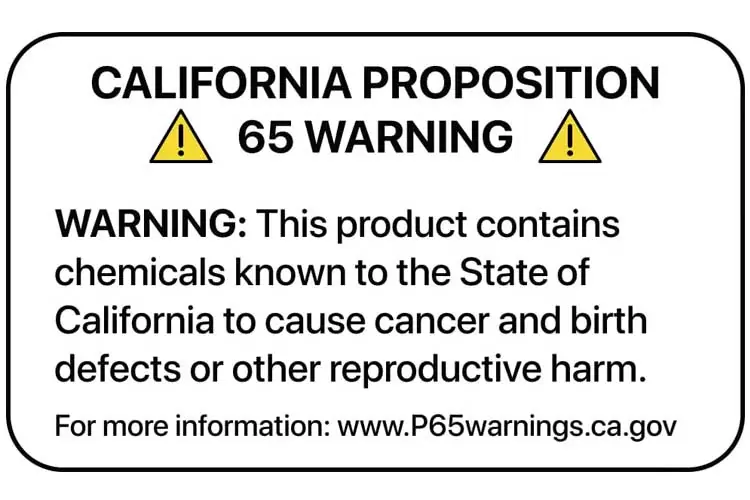
In an era where consumer awareness about product safety is paramount, understanding the implications of California Proposition 65 on clothing choices becomes crucial. This proposition mandates transparency regarding potential chemical exposures associated with products sold in the state, including apparel. This article delves into the intricacies of Proposition 65, explores the potential for chemical exposure in clothing, and guides consumers towards making informed decisions about California Proposition 65 clothing.
This comprehensive guide will outline the key aspects of Proposition 65, shed light on common chemicals found in clothing that may pose health risks, and provide practical tips for identifying and purchasing California Proposition 65 clothing. By equipping yourself with this knowledge, you can confidently navigate the world of apparel while prioritizing your well-being.
California Proposition 65
Enacted in 1986, California Proposition 65, officially known as the Safe Drinking Water and Toxic Enforcement Act of 1986, aims to protect Californians from exposure to harmful chemicals. The proposition requires businesses selling products within the state to provide clear warnings to consumers about potential exposures to substances listed on the Proposition 65 list. This list encompasses over 1,000 chemicals identified as known or probable carcinogens, reproductive toxins, or developmental toxins.
The scope of Proposition 65 extends beyond food and beverages; it applies to a wide range of consumer products, including clothing. Manufacturers and retailers are obligated to warn consumers about the presence of listed chemicals in their garments if those chemicals could exceed permissible exposure limits during normal use. These warnings typically appear as labels or tags on clothing items, alerting consumers to potential health risks associated with specific chemicals.
Chemical Exposure in Clothing

While many clothing materials are inherently safe, certain manufacturing processes and chemical treatments can introduce potentially harmful substances into garments. Some common chemicals found in clothing that may raise concerns under Proposition 65 include:
- Formaldehyde: Used as a wrinkle-resistant finish and dye fixative, formaldehyde can be released from fabrics during washing or wearing, potentially causing skin irritation, respiratory problems, and even cancer with prolonged exposure.
Lead: Found in some dyes and pigments, lead can accumulate in the body over time, leading to developmental issues in children and various health problems in adults.
Phthalates: These chemicals are often used as plasticizers in synthetic fabrics to enhance flexibility and durability. However, phthalates have been linked to endocrine disruption, reproductive issues, and potential developmental effects.
- Perchlorate: Used in flame-retardant treatments, perchlorate can interfere with thyroid function and potentially harm fetal development.
Proposition 65 Compliant Clothing
California Proposition 65 clothing refers to garments that meet the requirements outlined by the proposition. Manufacturers and retailers selling these products must ensure they comply with specific labeling regulations, providing clear warnings to consumers about any potential chemical exposures associated with their garments.
To achieve compliance, manufacturers may implement various strategies, such as using alternative materials or manufacturing processes that minimize the use of listed chemicals. They may also choose to label their clothing with Proposition 65 warnings, informing consumers about the presence of specific chemicals and potential health risks.
Certification and Labeling
While there is no official certification program for California Proposition 65 clothing, reputable brands and retailers often display clear labeling on their products indicating compliance with Proposition 65 requirements. These labels typically provide information about the specific chemicals present in the garment and any associated warnings. Consumers can look for phrases such as “Proposition 65 compliant” or “Warning: This product contains chemicals known to the State of California to cause cancer, birth defects, or reproductive harm.”
Finding Safe Garments

Navigating the world of California Proposition 65 clothing requires a discerning eye and informed decision-making. Here are some practical tips for finding safe garments:
- Read Labels Carefully: Always scrutinize garment labels for any Proposition 65 warnings or information about chemical content. Pay attention to specific chemicals mentioned and their potential health effects.
Choose Natural Fibers: Opt for clothing made from natural fibers such as cotton, linen, or wool whenever possible. These materials are generally less likely to contain harmful chemicals compared to synthetic fabrics.
Research Brands: Look for brands that prioritize sustainability and transparency in their manufacturing practices. Many ethical fashion companies actively minimize the use of harmful chemicals and provide detailed information about their products’ composition.
- Support Local Retailers: Consider shopping at local boutiques or independent retailers who may carry a curated selection of California Proposition 65 clothing. These businesses often prioritize quality and ethical sourcing.
Consumer Awareness
Ultimately, consumer awareness plays a pivotal role in driving change within the fashion industry. By demanding transparency from manufacturers and retailers, supporting brands that prioritize safety, and making informed purchasing decisions, consumers can collectively influence the production of safer and more sustainable clothing.
Conclusion
Understanding California Proposition 65 clothing empowers consumers to make informed choices about their apparel while prioritizing their health and well-being. By staying informed about potential chemical exposures, reading garment labels carefully, and supporting ethical brands, you can navigate the world of fashion with confidence, knowing that you are making responsible decisions for yourself and the environment.
